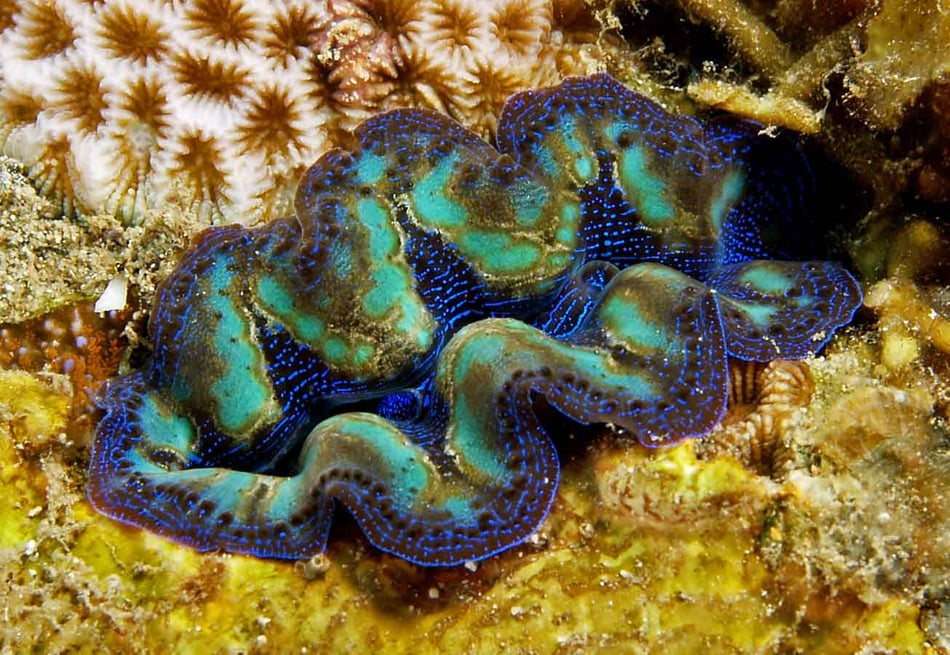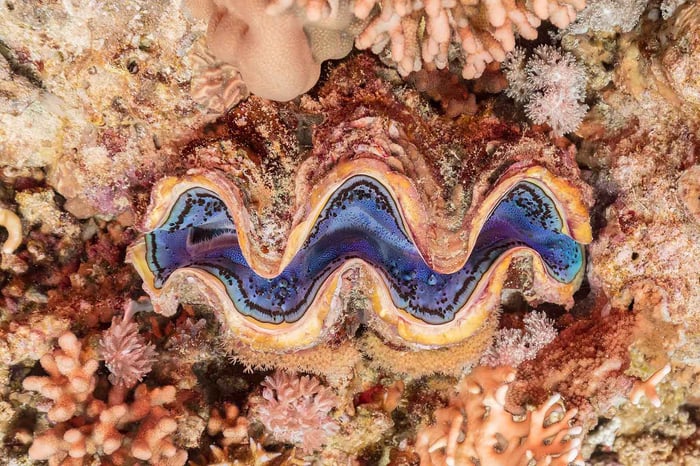What is so special about giant clams?

Jordan
5
min. read

What exactly are giant clams?
Giant clams are one of the most magnificent species in all the oceans; they are like living jewels adorning the seabed with their vibrant colors and intricate patterns. These outsized marine mollusks belong to the family Tridacnidae and are renowned for their impressive size and ornate shells. Found in the warm, shallow waters of coral reefs throughout the Indo-Pacific region, giant clams are awe-inspiring creatures that are impressive not only due to their sheer size and stunning colors, but also because of the unique ecological roles that they fill.
There are two things that set giant clams apart from regular bivalves: their remarkable size and their symbiotic relationship with photosynthetic algae known as zooxanthellae. With some species capable of reaching lengths exceeding 1.5 meters and weights surpassing 250 kilograms, giant clams are by far the largest living bivalves on the planet. But it is their unique symbiotic relationship with zooxanthellae algae, which reside within giant clam tissues and harness sunlight to produce energy through photosynthesis, that makes them truly special - and allows for them to grow to their enormous sizes. In return for the added nutrition that propels these clams to grow far beyond what filter feeding alone could provide, the clams provide shelter and nutrients to the algae, creating a mutually beneficial partnership that allows giant clams to thrive in nutrient-poor waters.
Despite their grandeur, giant clams face numerous threats, including overharvesting for their meat and shells, habitat destruction, and climate change-induced stressors such as rising sea temperatures and ocean acidification. Conservation efforts aimed at protecting these iconic creatures are therefore essential to safeguarding the health and biodiversity of coral reef ecosystems for future - and current - generations to enjoy.
There are two things that set giant clams apart from regular bivalves: their remarkable size and their symbiotic relationship with photosynthetic algae known as zooxanthellae. With some species capable of reaching lengths exceeding 1.5 meters and weights surpassing 250 kilograms, giant clams are by far the largest living bivalves on the planet. But it is their unique symbiotic relationship with zooxanthellae algae, which reside within giant clam tissues and harness sunlight to produce energy through photosynthesis, that makes them truly special - and allows for them to grow to their enormous sizes. In return for the added nutrition that propels these clams to grow far beyond what filter feeding alone could provide, the clams provide shelter and nutrients to the algae, creating a mutually beneficial partnership that allows giant clams to thrive in nutrient-poor waters.
Despite their grandeur, giant clams face numerous threats, including overharvesting for their meat and shells, habitat destruction, and climate change-induced stressors such as rising sea temperatures and ocean acidification. Conservation efforts aimed at protecting these iconic creatures are therefore essential to safeguarding the health and biodiversity of coral reef ecosystems for future - and current - generations to enjoy.
Differentiating between the different types of giants
Distinguishing between the various types of giant clams is no small feat. These gentle giants come in a dazzling array of colors, ranging from vivid blues and greens to striking purples and yellows. One way to differentiate between species is by examining the patterns and markings on their shells, each of which is unique to the particular species. Additionally, the shape and size of the shells can vary between species, with some boasting smoother, more elongated shells, while others exhibit pronounced ridges and folds.
The differences between the various species of giant clams being studied by the IMARCS Foundation (Tridacna noae, Tridacna gigas, Tridacna maxima, Tridacna squamosa, Tridacna derasa, and Tridacna crocea) can be described as follows:
The differences between the various species of giant clams being studied by the IMARCS Foundation (Tridacna noae, Tridacna gigas, Tridacna maxima, Tridacna squamosa, Tridacna derasa, and Tridacna crocea) can be described as follows:
Tridacna Gigas
Known as the true giant clam, Tridacna gigas is the largest species in the genus, capable of reaching lengths of up to 1.5 meters and weighing as much as 250 kilograms. Its massive shells are typically smooth and elongated, with vibrant colors ranging from blue-green to yellow. Tridacna gigas can be found in the warm waters of the Indo-Pacific region, including areas such as the Great Barrier Reef and the Red Sea, although they are now extinct from large areas of their natural habitat.

Image Credits - https://reefguide.org/tridacnagigas.html
Tridacna Squamosa
This species is distinguished by its scalloped, fluted shells and vibrant coloration, which can range from blue and green to purple and yellow. Tridacna squamosa tends to inhabit shallow reef flats and lagoons and is distributed across the Indo-Pacific, from the eastern coast of Africa to the western Pacific Ocean.

Tridacna Maxima
Tridacna maxima is notable for its striking colors and elongated, fluted shells. It exhibits a wide range of color variations, including blue, green, brown, and purple, often with intricate patterns. Tridacna maxima prefers shallow reef environments and is found throughout the Indo-Pacific region, from the Red Sea to the western Pacific Ocean.

Image Credits - https://en.wikipedia.org/wiki/File:Almeja_gigante_(Tridacna_maxima),_Temple,_Sharm_el-Sheij,_Egipto,_2022-03-26,_DD_33.jpg
Tridacna Derasa
Tridacna derasa is characterized by its large, elongated shells and relatively smooth appearance. It typically exhibits subdued coloration, with shades of brown, green, and blue. Tridacna derasa inhabits a variety of reef habitats, including shallow lagoons and deeper reef slopes, and is found throughout the Indo-Pacific region.

Image Credits - https://en.wikipedia.org/wiki/File:Tridacna_derasa_1.jpg
Tridacna Crocea
The smallest species in the genus, Tridacna crocea, is distinguished by its compact, elongated shells and vibrant colors, including blue, green, and yellow. It prefers shallow reef environments, such as reef flats and shallow lagoons, and is distributed across the Indo-Pacific region.

Tridacna Noae
This species is relatively small compared to others, typically reaching lengths of up to only 40 centimeters. It is characterized by its thick and irregularly shaped shells, often displaying a mix of brown, green, and blue colors. Tridacna noae is found in the western Pacific Ocean, particularly in regions such as the Philippines and Indonesia.

Image Credits - https://www.inaturalist.org/photos/42792300
These differences in size, coloration, shell characteristics, habitat preferences, and geographical distribution contribute to the diverse array of giant clam species that are found in coral reef ecosystems worldwide.
What makes these gentle giants so important?
Giant clams serve important ecological and environmental roles by ensuring or contributing to the following:
- Reef health
- Water filtration
- Microplastic catchment
- Sustainable source of protein
- Microhabitats
- Indicator species
The potential of giant clam shells
Giant clam shells are made from calcium carbonate (CaCO3), with half of this chemical compound composed of carbonate. In marine environments, carbonate is vital: it not only helps to maintain the pH balance of seawater but is also the key component of all bivalve shells and coral structures. Because of this, the IMARCS Foundation has began exploring the potential of utilizing giant clams as carbon sinks due to their ability to incorporate dissolved CO2 in seawater, in the form of carbonate, into their shells. This process is known as biomineralization and has already been studied as a means of long-term storage of carbon. While giant clams have not been extensively studied in this context, our early research suggests that their carbon sequestration potential could be harnessed to help mitigate climate change, at least as a proof of concept.
If you are interested in supporting our research in this area, please support us by sharing our work and helping spread awareness of the work that we are doing with giant clams.
If you are interested in supporting our research in this area, please support us by sharing our work and helping spread awareness of the work that we are doing with giant clams.
Further reading:
Featured Image Credits - https://www.snexplores.org/article/heres-how-clam-can-hide-within-rock
Mohammed, T. et al. (2019). Growth rates of the giant clam Tridacna maxima (Röding, 1798) reared in cages in the Egyptian Red Sea. The Egyptian Journal of Aquatic Research, Volume 45, Issue 1. https://doi.org/10.1016/j.ejar.2019.02.003
Su, P. et al. (2021). Reproduction and Early Juvenile Growth of the Giant Clams Tridacna noae and Tridacna maxima in Taiwan. Zoology Study, Volume 60, Issue 49. https://doi.org/10.6620/ZS.2021.60-49
Lebata-Ramos, M. et al. (2010). Growth and survival of hatchery-bred giant clams (Tridacna gigas) in an ocean nursery in Sagay Marine Reserve, Philippines. Aquaculture International, Volume 18, Issue 1. https://doi.org/10.1007/s10499-009-9272-4
Killam, D., Al-Najjar, T., & Clapham, M. (2021). Giant clam growth in the Gulf of Aqaba is accelerated compared to fossil populations. Proceedings of the Royal Society. https://doi.org/10.1098/rspb.2021.0991
Ow Yong, W. L., Todd, P. A., Ang, A. C. F., Ying, L. S. M., Teo, A., Lee, S. H. R., Low, J., & Neo, M. L. (2022). Fluted giant clam (Tridacna squamosa) restocking experiment in an urban turbid reef environment. Aquatic Conservation: Marine and Freshwater Ecosystems, 32(4), 633-644. https://doi.org/10.1002/aqc.3789
Neo, M. et al. (2017). Giant Clams (Bivalvia: Cardiidae: Tridacninae): A Comprehensive Update of Species and Their Distribution, Current Threats and Conservation Status. In S. J. Hawkins, D. J. Hughes, I. P. Smith, A. C. Dale, L. B. Firth, & A. J. Evans (Eds.), Oceanography and Marine Biology: An Annual Review, 55, 87-388. Taylor & Francis.
Beckvar, N. (2019). Giant Clam Mariculture: A Sustainable Approach to Reef Restoration. Journal of Shellfish Research, Volume 38, Issue 3.
Rädecker, N. et al. (2020). The role of giant clams in coral reef ecosystems: trends in epiphytic macroalgae. Marine Environmental Research, Volume 155.